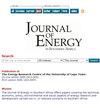小型风力发电机叶片有限元模型的应力验证
IF 0.6
4区 工程技术
Q4 ENERGY & FUELS
引用次数: 2
摘要
风力涡轮机叶片是风力涡轮机的第一个机械部件,它与风相互作用,因此在风力发电中起着关键作用。根据设计规范IEC 61400-23,如应变极限、疲劳寿命、叶尖间隙极限和表面应力,对风力涡轮机叶片进行结构完整性测试是很重要的。本文主要研究叶片静弯曲应力的计算与验证;对某小型风力机叶片进行了试验和模拟应力分析。有限元分析采用仿真与三维设计软件ANSYS 19.0进行。通过有限元分析,我们的目标是捕捉在静态加载和卸载条件下叶片几何形状上产生的应力。作为实现这一目标的第一步,将有限元结果与红隼E230i涡轮叶片的实验结果进行了验证。风力发电机叶片一端固定,在选定的三个点静态加载和卸载。有限元计算结果与实验结果误差在25%以内。使用逆向工程程序确定适当的ANSYS模型叶片性能,因为无法从制造商处获得确切的材料性能。本文章由计算机程序翻译,如有差异,请以英文原文为准。
Stress validation of finite element model of a small-scale wind turbine blade
Wind turbine blades are the first mechanical part of a wind turbine that interacts with the wind and hence play a key role in wind power generation. It is important that the wind turbine blade is tested for structural integrity in accordance to design code IEC 61400-23 such as strain limits, fatigue life, blade tip clearance limit, and surface stress. This paper aims to focus on the calculation and validation of static bending stresses in the blade; it presents the experimental and simulated stress analysis of a small-scale wind turbine blade. The simulation and 3D design software ANSYS, version 19.0 is used in the finite element analysis (FEA). By using FEA, we aim to capture the stress generated on the blade geometry under static loading and unloading conditions. As a first step towards this, the finite element results were validated against experimental results on a kestrel E230i turbine blade. The wind turbine blade was fixed at one end, loaded, and unloaded statically at three selected points. The finite element results are calculated within a 25% error margin of the experimental results. A reverse engineering procedure was used to determine the appropriate ANSYS model blade properties that were used as the exact material properties were not available from the manufacturer.
求助全文
通过发布文献求助,成功后即可免费获取论文全文。
去求助
来源期刊

Journal of Energy in Southern Africa
ENERGY & FUELS-
CiteScore
3.00
自引率
0.00%
发文量
16
审稿时长
6 months
期刊介绍:
The journal has a regional focus on southern Africa. Manuscripts that are accepted for consideration to publish in the journal must address energy issues in southern Africa or have a clear component relevant to southern Africa, including research that was set-up or designed in the region. The southern African region is considered to be constituted by the following fifteen (15) countries: Angola, Botswana, Democratic Republic of Congo, Lesotho, Malawi, Madagascar, Mauritius, Mozambique, Namibia, Seychelles, South Africa, Swaziland, Tanzania, Zambia and Zimbabwe.
Within this broad field of energy research, topics of particular interest include energy efficiency, modelling, renewable energy, poverty, sustainable development, climate change mitigation, energy security, energy policy, energy governance, markets, technology and innovation.
 求助内容:
求助内容: 应助结果提醒方式:
应助结果提醒方式:


